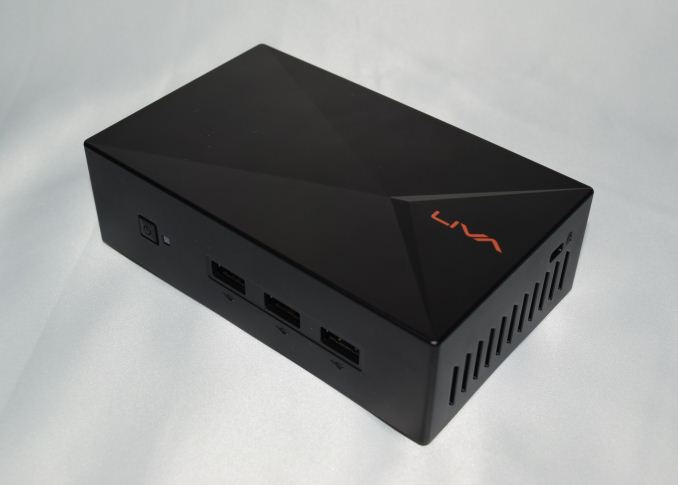ECS LIVA X Review: A Fanless Bay Trail-M mini-PC
by Ganesh T S on January 16, 2015 11:30 AM ESTFinal Words
The ECS LIVA X provided us with an opportunity to see how ECS could improve upon the baseline created by the ECS LIVA. We are happy to see that the LIVA X manages to fix many of the shortcomings without sacrificing any of the advantages brought forward by the LIVA. The misplaced thermal pads were a bit of a downer, but, considering that the LIVA had no thermal throttling issues and the heat sink is physically much better in the LIVA X, we have no doubt that customer shipments will not have any problems on that front.
The absence of SODIMM slots reduce the BOM cost and the eventual end-price for consumers (which is the reason the ECS LIVA X is cheaper than a Bay Trail NUC). A mSATA port makes an appearance for users interested in running Windows 7 (which doesn't have an eMMC driver). The Wi-Fi card came pre-installed, and the unit was good to go right after purchase, unlike the LIVA. The LIVA X provides an additional USB port and they are all in the front panel - that is a good decision considering the typical use case for such mini-PCs. The vertical orientation of the HDMI port also saves some space on the read panel, giving it a more uncluttered look.
The Celeron N2808 has Quick Sync enabled, and this provides some interesting use-cases. The availabiligy of a 64 GB SKU at launch is also welcome. 32 GB is not enough once a couple of Windows updates get installed.
Pricing is the final aspect that we will talk about. The 32 GB eMMC version will have a MSRP of $210, while the 64 GB version we evaluated will come in at $250. This is with 4 GB of RAM, but no OS. $250 is definitely a bit steep when we look at the competition. Particularly, the Zotac CI320 nano PLUS model with Win 8.1 + Bing sells for $252 with the operating system. It has a quad-core CPU and adopts passive cooling, just like the LIVA X. It has the 64 GB storage drive and DRAM replaceable too, in case things go wrong with those components. The WLAN card (1x1 802.11ac) is also better in the CI320 nano compared to the LIVA X (1x1 802.11n). The LIVA X does have 2 GB of RAM extra and a different industrial design (approximately the same volume, though). We still believe pricing must be much lower for better market reception. Other than that aspect, the ECS LIVA X ticks all the right boxes in terms of what users expect out of a passively cooled mini-PC.











35 Comments
View All Comments
zepi - Friday, January 16, 2015 - link
HEVC / H.265 decoding capabilities would also be of interest for all HTPC tests.Otherwise these are solid articles about htpc's.
YoloPascual - Friday, January 16, 2015 - link
Well, this might be the best looking NUC out there.yannigr2 - Friday, January 16, 2015 - link
Could you please try to do a review for this one?http://linuxgizmos.com/tiny-fanless-mini-pc-runs-l...
It looks much more interesting than the LIVA.
kaidenshi - Friday, January 16, 2015 - link
Ooo, the multi-LAN version of that would work great as a custom router/firewall!speculatrix - Wednesday, January 28, 2015 - link
Phoronix.com looked at the fitlettakeshi7 - Friday, January 16, 2015 - link
I think the Zotac PI320 is a much better value. It's $50 cheaper, has 2 more cores and comes with an OS. The only real advantage I see in this is more RAM.Oxford Guy - Monday, January 19, 2015 - link
What does anyone need those extra cores for?eanazag - Friday, January 16, 2015 - link
I'd like to see VGA ports die already, but I understand they may have customers looking for that. I'd rather see the HDMI and a DP port for the video out.kaidenshi - Friday, January 16, 2015 - link
At first I had the same reaction as you, then I remembered that a lot of digital signage (a target market for these devices) still uses VGA. Hell, I still have a 15" VGA only LCD around here somewhere, and I would be able to slap this on the back and make a great "kitchen PC" for when I'm cooking and need to research ingredients or methods.But yes, a DisplayPort or mini DisplayPort connector would make more sense, given how cheap DP to VGA adapters are.
jabber - Saturday, January 17, 2015 - link
I think what you are looking for there is a laptop.